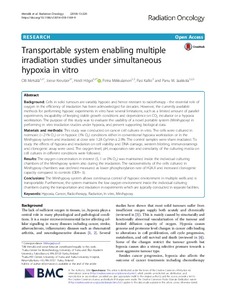Transportable system enabling multiple irradiation studies under simultaneous hypoxia in vitro
Olli Metsälä; Joose Kreutzer; Heidi Högel; Petra Miikkulainen; Pasi Kallio; Panu M Jaakkola
Transportable system enabling multiple irradiation studies under simultaneous hypoxia in vitro
Olli Metsälä
Joose Kreutzer
Heidi Högel
Petra Miikkulainen
Pasi Kallio
Panu M Jaakkola
BMC
Julkaisun pysyvä osoite on:
https://urn.fi/URN:NBN:fi-fe2021042720284
https://urn.fi/URN:NBN:fi-fe2021042720284
Tiivistelmä
BackgroundCells in solid tumours are variably hypoxic and hence resistant to radiotherapy - the essential role of oxygen in the efficiency of irradiation has been acknowledged for decades. However, the currently available methods for performing hypoxic experiments in vitro have several limitations, such as a limited amount of parallel experiments, incapability of keeping stable growth conditions and dependence on CO2 incubator or a hypoxia workstation. The purpose of this study was to evaluate the usability of a novel portable system (Minihypoxy) in performing in vitro irradiation studies under hypoxia, and present supporting biological data.Materials and methodsThis study was conducted on cancer cell cultures in vitro. The cells were cultured in normoxic (similar to 21% O-2) or in hypoxic (1% O-2) conditions either in conventional hypoxia workstation or in the Minihypoxy system and irradiated at dose rate 1.28Gy/min2.9%. The control samples were sham irradiated. To study the effects of hypoxia and irradiation on cell viability and DNA damage, western blotting, immunostainings and clonogenic assay were used. The oxygen level, pH, evaporation rate and osmolarity of the culturing media on cell cultures in different conditions were followed.ResultsThe oxygen concentration in interest (5, 1 or 0% O-2) was maintained inside the individual culturing chambers of the Minihypoxy system also during the irradiation. The radiosensitivity of the cells cultured in Minihypoxy chambers was declined measured as lower phosphorylation rate of H2A.X and increased clonogenic capacity compared to controls (OER similar to 3).Conclusions The Minihypoxy system allows continuous control of hypoxic environment in multiple wells and is transportable. Furthermore, the system maintains the low oxygen environment inside the individual culturing chambers during the transportation and irradiation in experiments which are typically conducted in separate facilities.
Kokoelmat
- Rinnakkaistallenteet [27094]
